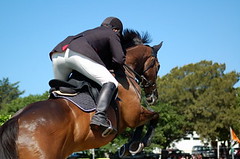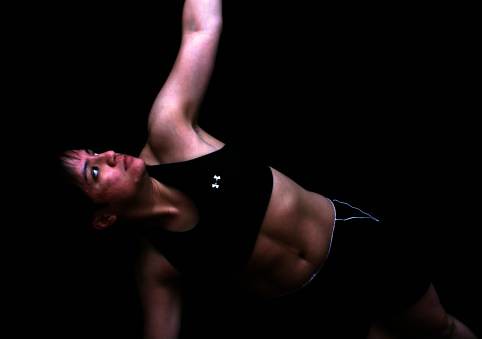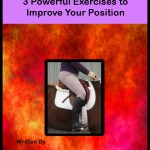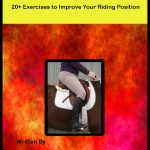How to Improve Your Riding Position – Get Those Legs Back Part 1
You can improve your riding postition by “Getting Your Legs Back! ”

![]() photo credit: Pam loves pie
photo credit: Pam loves pie
Welcome to our 1st installment from Laurie Higgins of Core Connexxions.
Because Laurie is both an active and life-long rider and certified in Pilates, she is well prepared to help you with your riding or other athletic endeavors through Pilates.
“The rider’s thighs should remain flat on the sides of the saddle and should be relaxed…but stretched from his hip, so that the knees stay low and back.”
Charles de Kunffy, “The Ethics and Passions of Dressage.”
“Reach back with your heels, keeping your knees down and back.”
Ange Bean, dressage instructor
“Be sure to bring your leg back behind you, not even slightly out in front of you.”
Me, Pilates Instructor

Don’t you just hate to keep hearing that? Teacher after teacher tells you to get your legs back, reach back with the heels, reach long with your leg, or reach down and back with the thigh or knee. They keep telling you over and over to do that. They might even come up with some crazy contraption or other to help you get those legs back. You’d really like to get them back, if only you knew how.
![]() photo credit: andreavallejos
photo credit: andreavallejos
What you and your instructor don’t know might be getting in the way of success.
Improve Your Riding Position – Get Your Legs Back
Here’s what you probably don’t know: You have to engage your deep, deep abdominal muscles first. Yes, folks, first. If you don’t access that transverse abdominal muscle first, you can’t move your leg. In any direction. Sounds crazy, but it’s true!
In order to move limbs, the trunk needs to be stabilized first. If the trunk or torso is not stable (no puns intended here), then the limbs are just flailing around or might actually be stuck or too tight. If the torso isn’t stable, something else needs to be. The body compensates by recruiting other muscles and body parts to the job the primary “worker bee” isn’t doing. Unfortunately, the substitute rarely does as good a job of it as the intended primary worker. ![]() photo credit: sergeant killjoy
photo credit: sergeant killjoy

So that we can all speak the same language, we need to establish some vocabulary. Abdominal muscles that help stabilize the trunk or spine include: Rectus abdominis (RA), external obliques, internal
obliques, and transversus abdominis (TA). Back muscles that stabilize the spine include: Quadratus lumborum (QL), erector spinae (there are several), lats, traps, and glutes (gluteus maximus, medius, and minimus). .
The larger, more extrinsic muscles, however, serve more as mobilizers than as stabilizers. The rectus abdominis (RA) or “six-pack” muscle is, therefore, more of a trunk mobilizer than a trunk stabilizer, but it does help stabilize to some extent. That’s just not its primary job. The quadratus lumborum (QL) can also stabilize but is more active in bending the trunk or lifting the hip.
From a Pilates standpoint (‘cause that’s where I’m standing) then, we need to focus on the deeper abdominal muscles – the obliques and, especially, the TA or transversus abdominis. This muscle is the deepest of the abdominals
The TA muscle runs around the body like a girdle. Most people can find the RA muscle. They might even be able to find the obliques. But most people are not on a first-name basis with their TA muscles.
The most fit or normal situation is for the TA muscle to fire as much as 1/10th of a second BEFORE activating a leg muscle – in any direction. That’s before moving a leg backwards, forwards, out to the side, or in toward the other leg. It doesn’t matter where you want to move that leg, you need access the TA muscle first to be effective about it. The worst scenario is for the TA to fire as much as half a second AFTER you move the leg.
If you’re having trouble getting your legs back and keeping them back, it may be because you can’t access your TA muscle to help stabilize the spine and the pelvis so that you can move the legs.
Remember when you were just learning to ride, hanging on for dear life with everything you had, crouched over the saddle and gripping with hands and knees, bouncing around all over the place? And someone asked you to sit tall, get your legs back, and – gasp – relax? Yeah, right. Somehow, over time, you managed it.
But remember how unstable you were, so you tried everything else to try to get stable – gripping, tightening, hunkering down. None of it helped, of course. But that’s what your body instinctively tried to do – compensate with what it perceived as a reasonable facsimile. Unfortunately, close doesn’t count.
So you got through the beginner lessons and now you ride pretty well. Now you’re focused on fine-tuning things a bit. Great. To do that you’ve got to find, and get to know, your TA muscle.
Here’s a way to help decide how well you’re using your abs (RA included). You’ll need a friend to do this, preferably one with a really good “eye” for details. Lie face down on the floor, with your head resting on your hands. With your friend watching carefully, lift your right leg off the floor in an extended position (straight through the knee). Do this slowly and carefully three to five times to give your friend lots of time to notice which muscles you’re using to lift your leg.
The most correct order for the right leg is: Right glutes (butt), right hamstring, left low back, right low back, left upper back, right upper back, and last, the neck.
If you happen to start with the hamstring and then the glutes, that’s okay. But if you’re starting with any other muscle first, you’ve got a bit of a problem. The worst possible scenario is trying to lift your leg with your neck. And as weird and illogical as that sounds, it happens.
What your friend can’t see, though, is that you really need to fire the abs, especially the TA, first before you try to lift your leg. So, now that you know how it’s supposed to go, try very hard to let you body go to its default mode so your friend can get a good, honest reading. Do this for both legs as they may be different.
Once you have your true reading, try again. But this time, focus on using your abs first, then lift your leg. Then try stabilizing your spine with your abs as before, but now engage the pelvic floor and lift your leg. What differences do you notice? It should be easier and more stable (no rolling around). What does your friend see now?
Straighten up and get those legs back!
Thank you to our guest post by Laurie Higgins of Core Connexxions http://coreconnexxions.com/About.html
In addition to providing excellent insight into how your body works she also treats dogs, cats, horses and other animals in addition to teaching Pilates and Energywork. Laurie was certified by EQUESTRIAN PILATES® in 2005. Laurie has been riding horses since she was 12 years old, having ridden western, hunt, and dressage. She is now able to keep her horses at home while she deepens her dressage practice on Atticus, her Anglo-Hanoverian gelding, and Ollie, a thoroughbred rescue.
 Try these three powerful exercises to get strengthen your position.
Try these three powerful exercises to get strengthen your position.

Thanks for this – Laurie and Laura. This is an interesting perspective. I’m curious, with riding horses, how important you feel being able to open your hip is relative to using muscles right when using your leg properly.
Thank you Nanette for your comment. I think that if you r leg is being used properly and in the correct position then your hips must be correctly aligned and ‘opened’. If you need to improve your leg postion these are some excellent exercises that you can use.
If you use your leg properly and use the correct muscles properly when riding, then your hips are a secondary thing. But that being said it is difficult to have your leg correctly placed with out having your hips correctly placed.
~Laura